The Complete Guide to eCommerce Personalization
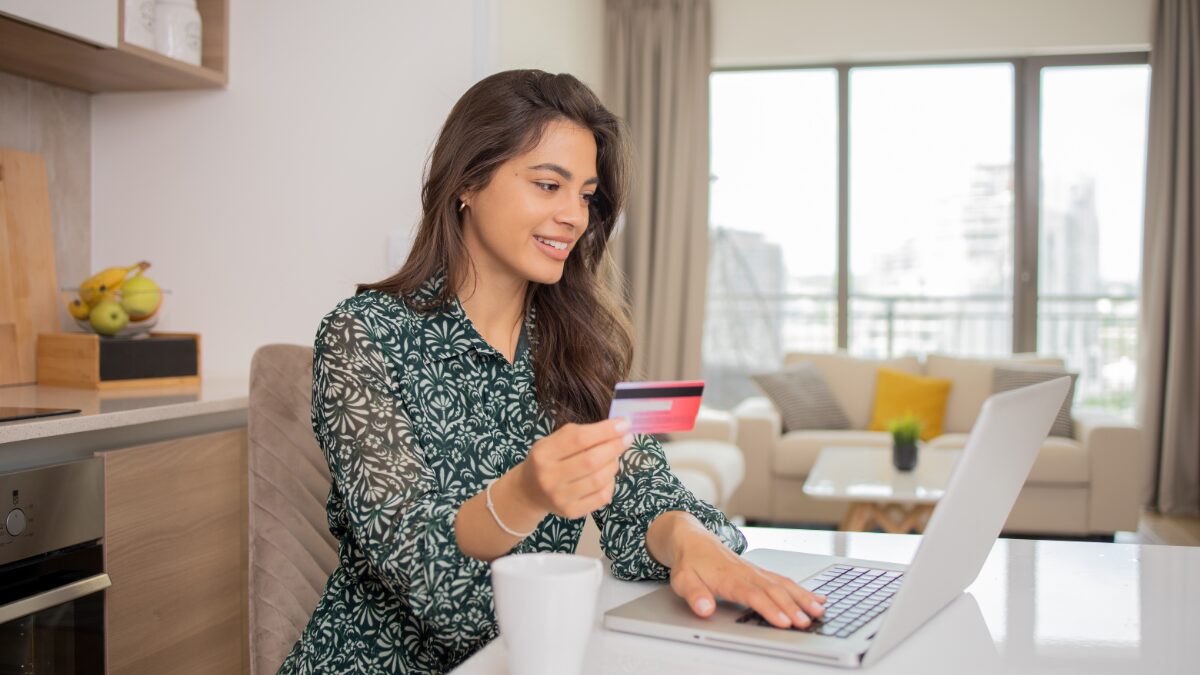
Personalization is critical to growing customer loyalty, increasing revenue and staying relevant with customers. Read on to learn more about what personalization is, why it’s so important for eCommerce, and the three things you’ll need to get started with personalization in your own eCommerce marketing.
What is personalization?
Personalization treats each customer as an individual. It means offering tailored marketing messages that are timely and relevant. At its heart, personalization is about creating a unique, seamless experience. Customers return to you because you provide offers that resonate with them, anticipate their needs and save them time.
Personalization covers a range of marketing activities, from incorporating product recommendations based on behavior to anticipating customer needs. Successful personalization engages your customers on your eCommerce website, app and in marketing emails with targeted content.
Research backs up the need for personalization:
- Our research with YouGov shows that two in five (41%) shoppers would drop a retailer who sends irrelevant offers and one in four actively want to be sent offers and recommendations based on previous purchases.
- Boston Consulting Group found that, as a general rule across all sectors, companies who create personalized experiences grow revenue by 6% to 10% – two to three times faster than those who do not.
- In retail specifically, McKinsey found that personalization increases revenue by 10% to 30%. That’s because marketers aren’t just making relevant suggestions but also learn to reach out when a customer is most likely to be in ‘shopping mode’.
What personalization isn’t
It’s also important to note what personalization isn’t.
It isn’t adding a customer’s first name to an email (in fact, one in three consumers don’t care if retailers call them by their name in marketing emails). It isn’t an automated retargeting ad showing what someone browsed on. And it isn’t creating marketing programs based on demographic segments. All of these tactics were early efforts to personalize the marketing experience. But with today’s technology, personalization has been taken to the next level.
What is eCommerce personalization?
To understand eCommerce personalization think about the shopping experience when customers knew the merchants they shopped with.
The store owner might greet a returning customer with information about a new item in stock that matched or complemented the products the customer bought in the past. For particularly loyal customers, the merchant might offer a small gift with the purchase, such as a free scarf to go with the new winter coat. Recommendations were regularly offered, and advice given.
Ecommerce personalization seeks to replicate that kind of one-to-one experience. In its most sophisticated form, it crafts behavioral triggers and contextual data into marketing messages that are appropriate to each customer’s stage in the lifecycle and purchase journey. So first-time buyers are treated differently to loyal customers, website browsers differently to cart abandoners etc.
In a nutshell, eCommerce personalization is when you deliver personalized experiences at every touchpoint, from the tactics you deploy to the type of marketing messages you serve, when you serve it and on which channel.
Ecommerce personalization tactics include:
- Email content that updates dynamically at the moment of open to display the most relevant content at that moment in time.
- Product recommendations that are based on behavior rather than wisdom of the crowd or business rules.
- Ecommerce sites that dynamically show a shopper’s favorite brands on the homepage or highlight content based on the shopper’s location or the weather forecast for their area.
- Website navigation bars that highlights the shopper’s favorite categories.
- Website pop-ups and banners that are tailored to the shopper’s browsing history or lifecycle stage.
Here are some eCommerce personalization examples to demonstrate those tactics in action:
Product recommendations
Getting Personal personalizes their browse abandonment emails with recommendations based on the products the shopper has browsed. This enables the online retailer to showcase more of their products, in turn helping customers find the right item for them.
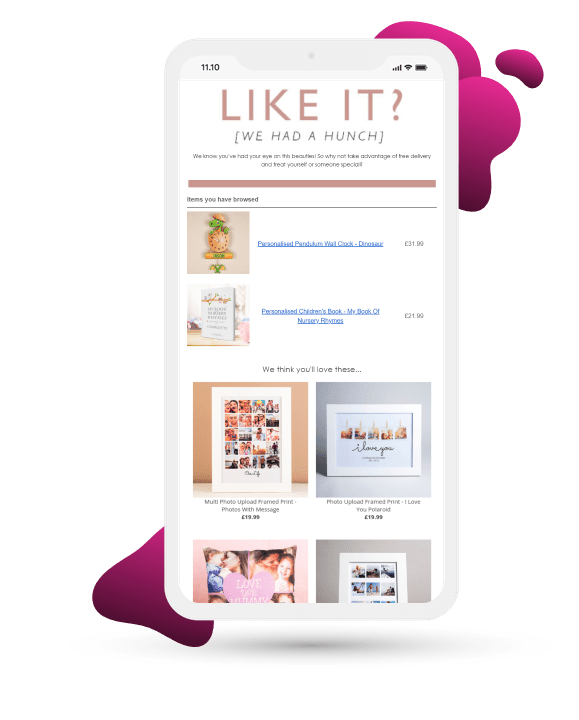
Source: Getting Personal email
Geotargeting
Cooksongold identifies whether visitors to their website are based in the UK, EU or the rest of the world and displays a tailored welcome offer and free delivery information depending on where they are based. This ensures that each website visitor sees practical information that’s most relevant and useful to them, helping to create a more convenient customer experience.
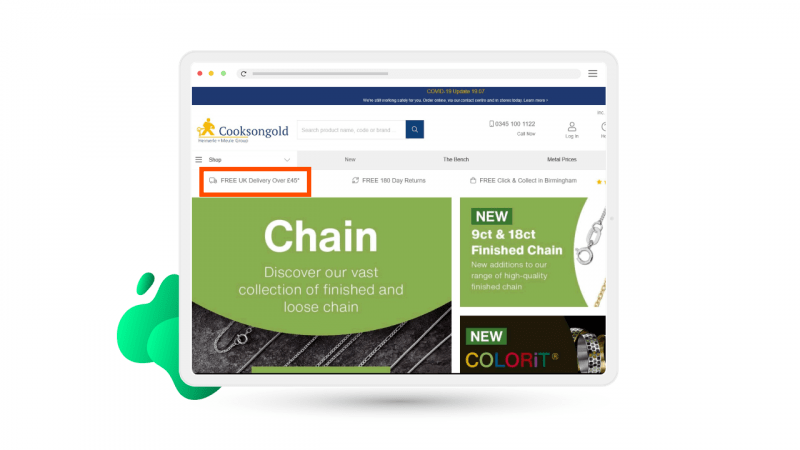
Cooksongold’s hompage personalized for UK visitors
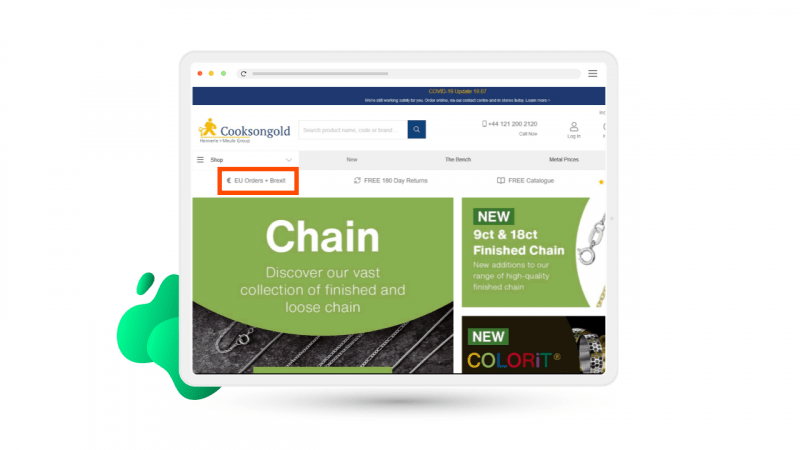
Cooksongold’s homepage personalized for EU visitors
Source: cooksongold.com
Pop-ups
Cottages.com uses popovers to remind visitors of their last viewed product, helping them save time and pick up where they left off.
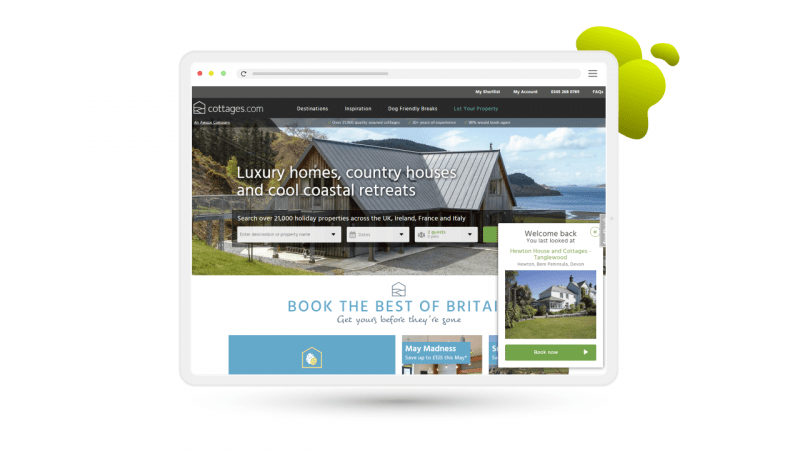
How website personalization helps eCommerce thrive
As you might have gathered by now, to master eCommerce personalization you must provide personalized experiences across every channel. All channels require a personal touch in order to have an impact on revenue, but website personalization, is particularly effective when it comes to converting new first-time visitors.
First impressions matter and with website personalization technology, marketers are able to impress new visitors by personalizing pages based on:
- traffic source
- number of visits
- what they have previously browsed or carted
This way marketers can make the most of every dollar spent on ads getting new visitors to the site.
Personalization vs demographic segmentation
The two tactics are sometimes conflated but are not the same. Segmentation groups shoppers who share a defining characteristic to create more targeted messaging. It is a key component of personalization, but it does not help marketers achieve 1-to-1 personalization.
Demographic-based segmentation for example assumes that everyone who shares a gender, age group or location will shop in the same way for the same goods.
Personalization sometimes employs customer segments but goes further. A female millennial and a middle-aged man may appear to be very different. However, they are likely to have a lot more in common than other people in their demographic niche if they are both, say, keen surfers looking for a new surfboard. Different demographics, but a shared interest, puts them in the market for the same product.
Demographic segmentation is not personalization for another reason: We regularly purchase goods for someone else, whether it’s for other members of the family or wider gifting. That same millennial female shopper and middle-aged man would again look very different in terms of demographics, right up to the point when they are buying children’s clothes. It might be for their own family or it could be as a gift; the point is, two very different looking customers are both interested in the same product segment.
A customer’s behavioral and contextual data are required to make the experience more personal.
Personalization statistics
Personalization is a proven way to generate results for your business. Here are some website personalization stats to show you why:
- 89% of digital businesses are investing in personalization. (Forrester)
- 4 in 5 companies (80%) report an uplift since implementing personalization. (Econsultancy)
- 71% of consumers expect personalization. (McKinsey)
- Basic website personalization can give a 14% sales uplift. (Fresh Relevance)
- 79% of consumers are willing to share relevant information about themselves for personalized product recommendations. (Salesforce)
Why behavioral targeting fueled by real-time data is critical to personalization
Shoppers tell you a lot about themselves by how they interact with your online store and your emails.
What a shoppers is looking at on your eCommerce site and what they are clicking through in your email campaigns – perhaps social posts and adverts too – reveals what they are interested in far more than demographic or even previous purchase data.
How they react to marketing messages is another indication of intent. If someone is researching a particular product and reacts to your marketing efforts by clicking back to take another look, you can bet that this is an item they are interested in. If they looked at the product once, and have ignored subsequent messages, they’ve likely moved on.
To use behavioral data effectively you need to work in real-time. You have to capture the behavior as it is happening and trigger the appropriate message or adjust what they are seeing on your website (such as a pop-up with a free shipping offer).
Key difference between B2C and B2B personalization
Unlike B2C eCommerce customers, B2B eCommerce customers are typically high value and relatively small in number. This means it’s even more vital to personalize the B2B eCommerce experience and make the most of every single customer interaction. Providing a seamless and personalized buying experience enables B2B businesses to help customers buy more easily and explore more of the product range.
B2B eCommerce businesses often have multiple price lists (e.g. logged-in trade vs retail vs logged-out trade), so it can be useful to personalize the experience by displaying the correct prices for each individual’s contract.
Other personalization tactics such as triggered messaging helps B2B eCommerce businesses get as close to 1:1 marketing as possible with their valued trade buyers.
How to get started with personalization
There are three things you’ll need to get started with personalization: Data that is joined up, real-time content, and techniques to make sense of it all.
Ecommerce personalization requires dynamic content
The more data you are able to gather about your customers, the more refined and targeted marketing messages become. Being able to collect various types of data is important, but you also need to marry data collected through various channels to achieve a holistic customer view and use these insights to enhance the brand experience.
While you can trigger web personalization using cookies, you can’t send any personalized emails without an email address offered by the customer for marketing purposes. The email address often acts as the unique identifier. With it, you can match the address to other data you’ve collected.
A personalization platform that is able to identify shoppers across channels and devices, even when they haven’t identified themselves, e.g. by logging into their account, will help you collect rich customer data – a vital ingredient for any effective personalization campaign.
Ecommerce personalization requires dynamic content
To really enhance the experience, eCommerce personalization needs to provide value to the customer. Real-time data is vital for making that happen. If you send an email about a flash sale, and the customer opens the email a day later, will it lead them to sold out products? That’s a bad experience, as is getting a cart abandonment email after they’ve placed an order. To truly resonate, content needs to update dynamically to reflect the context when the shopper engages with it.
Tactics and techniques
For many brands and retailers, a triggered email campaign is their first experience with personalization. Or they add behavior-based product recommendations to abandoned cart messages, but won’t use similar recommendations on the website.
Instead of focusing on a specific kind of campaign or channel, you need to align personalization initiatives across as many channels as possible to ensure a seamless experience.
Finally, you need to present the most relevant content to guide shoppers along the customer journey and increase conversions. Personalization can be based on a multitude or combination of factors, including the stage in the customer lifecycle and purchase journey, preferences or contextual data, such as time and location.
Lifecycle stage
Tailor content to the lifecycle stage of each individual in order to acquire, grow and retain customers.
For example, your website hero banner could show:
- Data capture form to new visitors
- Sneak peek of new products to loyal customers
- Personalized coupon code to lapsed customers
Purchase stage
Display the content that resonates with the shopper’s stage in the purchase journey and helps drive conversions.
For example, your email header banner could show:
- Best-selling products to browse abandoners
- Free express shipping offer to cart abandoners
- Request to write a product review to recent purchasers
Behavior
Sell vacation packages? Mid-December searchers that have browsed and bought island vacations in the past should see some similar choices, perhaps with a countdown timer for those that want to leave after Christmas.
Time of day
Do you sell baby gear? Why not personalize the website to feature your products for helping baby sleep better for customers that visit the site between 10 pm and 6 am. Especially if the customer has browsed on those products in the recent past.
Location and weather forecast
Recommend products based on the shopper’s location and the weather forecast. For example, promote sunny holiday destinations to shoppers who open your email on a rainy day.
The psychology behind eCommerce personalization
The magic of personalization lies in its ability to connect with people on a human level. It’s about more than just metrics—it’s about understanding and responding to human behavior. Let’s delve into the psychology behind eCommerce personalization and see why it resonates so deeply with customers.
The Cocktail Party Effect
Ever been at a party or a crowded pub, where music is blaring and conversations are buzzing, yet you can still focus on the conversation you’re having? This phenomenon is known as the ‘cocktail party effect,’ a theory developed in the 1950s by British cognitive scientist Colin Cherry.
So, how does this relate to eCommerce?
On average, we encounter over 5,000 ads per day. Can you recall even 100 of them? Probably not, thanks to the cocktail party effect. Our brains filter out irrelevant information, including most advertisements.
As a business, how can you cut through the noise?
The answer is true personalization. With countless emails and social media ads vying for attention, simply using a customer’s name isn’t enough.
The Psychology of Persuasion
Robert Cialdini’s book Influence: The Psychology of Persuasion outlines six principles that can help convince people to make decisions:
- Similarity: We tend to like others who are similar to us.
- Consistency: We desire to be consistent with our past actions and statements—think brand loyalty.
- Scarcity: We want things that are rare.
- Consensus: We follow the lead of others.
- Authority: We trust experts.
- Reciprocity: We feel compelled to give back to those who give to us.
Utilizing Personalization
Now that you understand the cocktail party effect and the principles of persuasion, let’s apply these theories to your marketing strategy.
Tailored Product Recommendations
Shoppers want to see products that resonate with them. By showing recommendations similar to what they’ve browsed, you increase the chances of them finding something they love and even upselling. Post-purchase emails can suggest products that ‘people like you’ bought, fostering loyalty and consistency.
Scarcity Messaging
Scarcity is powerful for low-stock items like hotel rooms or limited editions. Use dynamic countdown timers on your website to show sale end times or stock levels. Phrases like ‘For a limited time only!’ and ‘While stock lasts’ create urgency.
Social Proof
People trust the wisdom of the crowd. Allowing customers to leave reviews and star ratings can attract new shoppers. Reciprocity plays a role here—satisfied customers often want to give back by sharing feedback. Use star ratings in emails and on your website, combined with product recommendations.
Influencers and experts can also boost your brand’s credibility. Over half of Gen Z prefers brands that use influencers, though only 14% of baby boomers feel the same. Know your audience to leverage this effectively.
What’s next? eCommerce personalization trends in 2025 and beyond
Personalization continues to evolve, and customers now expect more than just tailored product suggestions. To keep up with rising expectations, brands need to go further—creating experiences that feel relevant, timely and truly one-to-one. Here are 11 eCommerce personalization trends that reflect where the industry is headed. They build on the fundamentals covered in this guide and offer a practical look at how brands are unlocking deeper engagement in 2025.
AI and machine learning
Artificial Intelligence and Machine Learning remain at the core of effective personalization. These tools allow marketers to analyse large volumes of customer data and automatically deliver relevant product suggestions, content and offers based on real-time behaviour. From predictive recommendations to smarter chatbots, AI is helping brands personalise at scale.
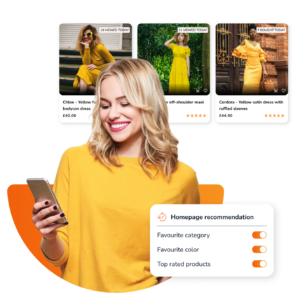
Hyper-personalization
Hyper-personalization goes beyond static segments by using real-time context to adapt each shopper’s experience. This includes tailoring content based on a customer’s location, time of day, weather and device. For instance, a customer browsing in the evening on mobile might see a different set of recommendations than the same person browsing on desktop during the day.

Cross-channel personalization
Customers don’t think in channels—they just expect things to work. That’s why successful personalization now spans every touchpoint: website, app, email, SMS, ads and even in-store. When each interaction feels consistent and connected, it creates a smoother journey and encourages loyalty.
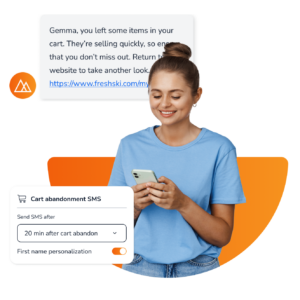
Voice search and personalization
Voice assistants are becoming a bigger part of how people search for products. As voice search grows, eCommerce businesses are optimising their product discovery and content to match conversational queries. Personalizing these voice experiences helps improve accuracy and relevance for the shopper.
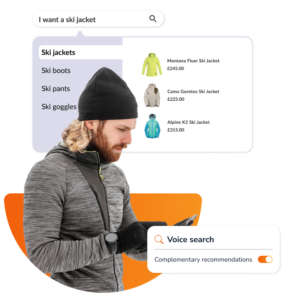
User-Generated Content (UGC)
Ratings, reviews and customer photos can significantly influence buying decisions. Showing user-generated content based on a shopper’s interests or browsing history adds credibility and relevance. It also provides valuable social proof at key moments in the customer journey.
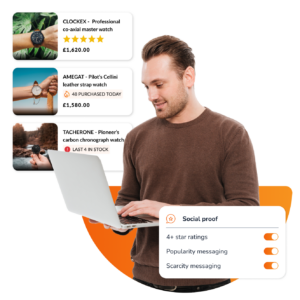
Augmented reality (AR) and virtual reality (VR)
AR and VR are helping customers visualise products in a more interactive way. From virtually trying on clothes to seeing how a sofa fits in their living room, these technologies enhance confidence and make the shopping experience more personal and engaging.
Sustainability personalization
Sustainability matters more than ever. Shoppers increasingly want to see product options and delivery choices that align with their values. Offering eco-friendly filters, low-emissions delivery or personalised sustainability badges helps connect with environmentally conscious customers in a meaningful way.
Personalization for B2B eCommerce
B2B buyers expect the same level of ease and relevance as B2C customers. That’s why more B2B platforms are adopting personalised pricing, product recommendations and automated messaging. Tailoring the experience to the needs of professional buyers helps drive efficiency and loyalty.
Using Zero-and First-Party Data
With third-party cookies on the way out, the focus is now on collecting and using data customers choose to share. Zero-party data comes directly from the customer via forms or preference centres. First-party data is based on observed behaviour, such as browsing history or purchase activity. Combining the two creates more accurate, effective personalization.
Generative AI for content Personalization
Generative AI is helping marketers create personalised content more efficiently. Whether it’s generating product copy, promotional messages or tailored headlines, AI tools are making it easier to test and adapt content based on customer behaviour and preferences. This reduces manual workload while increasing relevance at scale.
Loyalty-driven personalization
Loyalty programmes are becoming more dynamic, with personalised rewards, reminders and offers based on individual shopping habits. For example, a customer might receive a birthday discount, an early product preview or bonus points based on past purchases. This kind of recognition builds deeper emotional loyalty.
Pricing personalization – dynamic price
Personalization doesn’t stop at what you recommend—it can shape what you charge, too. Dynamic pricing uses real-time data to adjust prices based on factors like demand, stock, shopper behaviour and even time spent browsing.This allows you to personalise pricing at a segment level, targeting shoppers with offers or discounts they’re most likely to convert on. For example, a high-intent visitor who’s lingered on a product page might see a time-limited price drop, while loyal customers could receive exclusive rates based on past purchases.Done well, it makes pricing feel more relevant and responsive—helping increase conversions without devaluing your products.
These trends highlight just how fast personalization is moving—and how central it has become to successful eCommerce. While you don’t need to adopt every tactic at once, identifying the ones that align with your goals is a great place to start.The key is to stay focused on the customer. The more relevant and helpful your experience feels, the more likely customers are to return. To explore the building blocks of a great personalization strategy, head back to the main sections of this guide for practical tips, real examples and tools to help you take the next step.
Selecting the right technology is the first big hurdle to a personalization strategy. Choose a best-of-breed platform that allows you to make changes to your campaigns without the usual barriers of external or internal IT teams. Make sure that the platform is easy-to-use, yet sophisticated — displaying personalized content automatically and constantly iterating with AI-driven optimization while allowing you to maintain full merchandising and brand control..
Data collection is the next important step in eCommerce personalization. Gather information on customer behavior, preferences, and interactions. This data serves as the foundation for future personalization, so make a strategic plan for gathering the data you will need.
However, here’s an important tip: Don’t collect data you won’t use. It will annoy your customers unnecessarily to provide data you don’t need. You can always collect more data as you progress in your relationship.
Now that you have a sizable database, it’s time to put your AI tools to work to divide your audience into logical segments. By dividing customers into distinct segments based on their behavior, demographics, and preferences, you can create tailored experiences for each group. This approach ensures that personalization is not one-size-fits-all but caters to the unique needs and desires of different customer segments.
Once the audience is segmented, create your personalized offers and content based on your business objects and the preferences of each customer segment. Personalization should extend across various customer touchpoints, including email marketing, product pages, mobile app, SMS and social media ads. Consider mobile at every touchpoint to ensure a seamless and personalized shopping experience across devices.
Test. Optimize. Test again. Too slow. Use AI-powered optimization for faster results than manual A/B testing and optimization. By constantly monitoring and deploying top-performing content, you increase ROI and ensure a highly relevant customer experience. This capability is particularly useful for time-bound events (i.e., Black Friday, Valentine’s Day, etc.). Also, make sure you are providing your customers with a feedback loop. Listening to customer feedback and adapting strategies accordingly is essential. The goal is to continuously refine and improve the personalized customer experience, ensuring it remains relevant and effective in the ever-evolving eCommerce landscape.
A final word on eCommerce personalization
Just like there shouldn’t be one way you market to shoppers, there is no one way to deploy personalization. You should start small with quick wins, and enhance your campaigns step by step to make them more advanced. In the search for tactics, you need to keep one thing in mind: All efforts must lead to a shopping experience that delights customers and encourages them to come back again and again.
Find out more about our industry-leading Personalization Platform.



